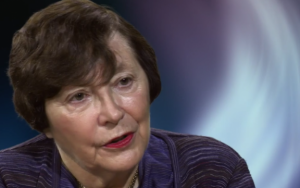Nancy Andreasen: Biography and Schizophrenia Research


Written and verified by the psychologist Gema Sánchez Cuevas
Dr. Nancy Andreasen is a psychologist from the United States. She holds the Andrew H. Woods Chair of Psychiatry and is and Director of its Neuroimaging Research Center and the Mental Health Clinical Center at The University of Iowa Carver College of Medicine.
Although you may not have heard of her, Dr. Nancy Andreasen is a renowned researcher who has made important contributions to the study of schizophrenia. But she hasn’t always been involved in medicine. Dr. Andreasen actually has a Ph.D. in English literature, with specialization in Renaissance literature. She worked as a professor in that field until her life took an unexpected turn. After the birth of her first daughter, Andreasen had some serious health problems that inspired her to study medicine.
Her research, however, isn’t limited to psychiatry. Andreasen studies creativity, spirituality, neuroimaging, genomics, natural history, and the neural mechanisms of schizophrenia. Keep reading to discover this woman’s scientific contributions.

Nancy Andreasen’s “firsts”
Dr. Nancy Andreasen is a pioneer in many ways. Her career is marked by a series of important “firsts”:
- She carried out the first quantitative MRI study of schizophrenia.
- She developed the first scales of measurement of the positive and negative symptoms of schizophrenia.
- Dr. Nancy Andreasen carried out the first modern empirical study of creativity that examined factors such as family, environmental cognition, and their relationship with mental illness.
- She carried out the first study that combined genomic and neuroimaging techniques.
Dr. Andreasen also contributed to psychiatric diagnosis in the DSM-III and DSM-IV task groups. In fact, she was responsible for building the foundation for stress disorder research with her definition of Post-Traumatic Stress Disorder (PTSD) for the DSM-III.
Andreasen was also the president of the American Psychopathological Association and the Psychiatric Research Society. She’s currently a member of the Institute of Medicine of the National Academy of Sciences and the American Academy of Arts and Sciences.
Schizophrenia research
Dr. Andreasen is a leading expert in the field of schizophrenia. She has carried out numerous studies and has contributed to the understanding of the mechanisms and treatment of this disease.
Schizophrenia is one of the leading public health problems we face today. It affects 1% of the population. According to the World Health Organization, it’s in ninth place in the medical illness category in terms of the global burden of disease. It’s above cancer, AIDS, heart disease, diabetes, and other important illnesses.
The signs and symptoms of schizophrenia are diverse. They include perception disorders (i.e. hallucinations), inferential thinking (i.e. delusions), disorganized thinking, and extremely disorganized or abnormal motor behavior, among others. However, none of the signs and symptoms are pathognomonic (specific to that disease).
Thus, none of the patients suffer from all the symptoms. Consequently, schizophrenia differs from other mental illnesses that generally only affect one brain system. Some examples are Alzheimer’s, which affects memory, and bipolar disorder, which affects mood.
The reconceptualization of schizophrenia
Dr. Nancy Andreasen’s modern reconceptualization of schizophrenia divides the symptoms into two categories: positive and negative. She defines positive symptoms as an exaggeration of normal functions (the presence of something that should be absent) and negative symptoms as the loss of normal functions (the absence of something that should be present).
- Positive symptoms include delusions, hallucinations, disorganized speech, and disorganized behavior.
- Negative symptoms include poor speech and thought, loss of motivation, anhedonia, apathy, and emotional numbness.
In the language of neuroscience, schizophrenia is an illness that affects distributed neural circuitry instead of individual cells or individual regions. Most people with schizophrenia have a subjective sensation that their ability to think and feel is disorganized or disconnected in some way.
Neuroimaging has allowed scientists to study how the brains of schizophrenic patients work differently. These studies have demonstrated that the subjective “disconnection” or “disorganization” experiences reflect a problem in the ability of distributed brain regions to send messages back and forth in an efficient and precise way.
The etymology of the word schizophrenia is a perfect description of the disease. It literally means “fragmented or disconnected mind.” That is exactly what scientists have seen through neuroimaging.

A life dedicated to research
These days, Dr. Nancy Andreasen continues her research to expand our knowledge of schizophrenia so that we can improve the treatment of the disease. She is working on structural and functional neuroimaging studies, longitudinal course and results studies, and studies that examine genetic and genomic factors and integrates them with neuroimaging studies.
Dr. Nancy Andreasen is, without a doubt, a key figure in the fields of psychiatry and schizophrenia.
All cited sources were thoroughly reviewed by our team to ensure their quality, reliability, currency, and validity. The bibliography of this article was considered reliable and of academic or scientific accuracy.
-
Andreasen, N. C., Berrios, G. E., Bogerts, B., Brenner, H. D., Carpenter, W. T., Crow, T. J., … & Lewine, R. R. J. (2012). Negative versus positive schizophrenia. Springer Science & Business Media.
-
Arndt, S., Alliger, R. J., & Andreasen, N. C. (1991). “The distinction of positive and negative symptoms: The failure of a two-dimensional model”. The British Journal of Psychiatry, 158(3), 317-322.
- Meet Dr. Nancy Andreasen. Retrieved from http://www.nancyandreasen.com/
This text is provided for informational purposes only and does not replace consultation with a professional. If in doubt, consult your specialist.








